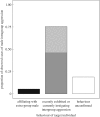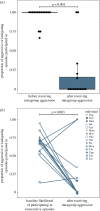Male monkeys use punishment and coercion to de-escalate costly intergroup fights
- PMID: 29875293
- PMCID: PMC6015864
- DOI: 10.1098/rspb.2017.2323
Male monkeys use punishment and coercion to de-escalate costly intergroup fights
Abstract
In numerous social species, males direct aggression towards female group members during intergroup fights, and this behaviour is commonly thought to function as mate guarding, even though males often target non-receptive females. In studying intergroup fights in a wild population of vervet monkeys, we found that male intragroup aggression was primarily directed towards individuals who had either just finished exhibiting, or were currently attempting to instigate intergroup aggression. Targeted females were less likely to instigate intergroup aggression in the future, indicating that male intragroup aggression functioned as coercion (when directed towards those who were currently trying to instigate a fight) and punishment (when directed towards those who had recently fought). These manipulative tactics effectively prevented intergroup encounters from escalating into fights and often de-escalated ongoing conflicts. Males who were likely sires were those most likely to use punishment/coercion, particularly when they were wounded, and, therefore, less able to protect vulnerable offspring should a risky intergroup fight erupt. This work, along with our previous finding that females use punishment and rewards to recruit males into participating in intergroup fights, highlights the inherent conflict of interest that exists between the sexes, as well as the role that social incentives can play in resolving this conflict. Furthermore, unlike other studies which have found punishment to be used asymmetrically between partners, these works represent a novel example of reciprocal punishment in a non-human animal.
Keywords: herding; mate defence; offspring protection; reciprocal punishment; social incentive.
© 2018 The Author(s).
Conflict of interest statement
We declare we have no competing interests.
Figures


Similar articles
-
Female monkeys use both the carrot and the stick to promote male participation in intergroup fights.Proc Biol Sci. 2016 Nov 30;283(1843):20161817. doi: 10.1098/rspb.2016.1817. Proc Biol Sci. 2016. PMID: 27881752 Free PMC article.
-
Network-level consequences of outgroup threats in banded mongooses: Grooming and aggression between the sexes.J Anim Ecol. 2021 Jan;90(1):153-167. doi: 10.1111/1365-2656.13323. Epub 2020 Sep 28. J Anim Ecol. 2021. PMID: 33428240
-
Male food defence as a by-product of intersexual cooperation in a non-human primate.Sci Rep. 2016 Oct 24;6:35800. doi: 10.1038/srep35800. Sci Rep. 2016. PMID: 27775042 Free PMC article.
-
Punishment in animal societies.Nature. 1995 Jan 19;373(6511):209-16. doi: 10.1038/373209a0. Nature. 1995. PMID: 7816134 Review.
-
Resolving social conflict among females without overt aggression.Philos Trans R Soc Lond B Biol Sci. 2013 Oct 28;368(1631):20130076. doi: 10.1098/rstb.2013.0076. Print 2013. Philos Trans R Soc Lond B Biol Sci. 2013. PMID: 24167306 Free PMC article. Review.
Cited by
-
Key individuals catalyse intergroup violence.Philos Trans R Soc Lond B Biol Sci. 2022 May 23;377(1851):20210141. doi: 10.1098/rstb.2021.0141. Epub 2022 Apr 4. Philos Trans R Soc Lond B Biol Sci. 2022. PMID: 35369758 Free PMC article. Review.
-
Variation between species, populations, groups and individuals in the fitness consequences of out-group conflict.Philos Trans R Soc Lond B Biol Sci. 2022 May 23;377(1851):20210148. doi: 10.1098/rstb.2021.0148. Epub 2022 Apr 4. Philos Trans R Soc Lond B Biol Sci. 2022. PMID: 35369741 Free PMC article. Review.
-
Punishment: one tool, many uses.Evol Hum Sci. 2019 Nov 12;1:e12. doi: 10.1017/ehs.2019.12. eCollection 2019. Evol Hum Sci. 2019. PMID: 37588410 Free PMC article. Review.
-
Human and nonhuman norms: a dimensional framework.Philos Trans R Soc Lond B Biol Sci. 2024 Mar 11;379(1897):20230026. doi: 10.1098/rstb.2023.0026. Epub 2024 Jan 22. Philos Trans R Soc Lond B Biol Sci. 2024. PMID: 38244597 Free PMC article.
-
Context-dependent alarm responses in wild vervet monkeys.Anim Cogn. 2023 Jul;26(4):1199-1208. doi: 10.1007/s10071-023-01767-0. Epub 2023 Mar 17. Anim Cogn. 2023. PMID: 36930451 Free PMC article.
References
-
- Huntingford FA, Turner AK. 1987. Animal conflict, p. 448 New York, NY: Chapman and Hall.
-
- Trivers RL. 1972. Parental investment and sexual selection. In Sexual selection and the descent of man (ed. Campbell B.), pp. 136–179. Chicago, IL: Aldine Publishing Company.
-
- Smuts BB, Smuts RW. 1993. Male aggression and sexual coercion of females in nonhuman primates and other mammals: evidence and theoretical implications. Adv. Study Behav. 22, 1–63. (10.1016/S0065-3454(08)60404-0) - DOI
-
- Muller MN, Wrangham R. 2009. Sexual coercion in primates and humans: an evolutionary perspective on male aggression against females, p. 496 Cambridge, MA: Harvard University Press.
-
- Fashing PJ. 2001. Male and female strategies during intergroup encounters in guerezas (Colobus guereza): evidence for resource defense mediated through males and a comparison with other primates. Behav. Ecol. Sociobiol. 50, 219–230. (10.1007/s002650100358) - DOI
Publication types
MeSH terms
Associated data
LinkOut - more resources
Full Text Sources
Other Literature Sources

